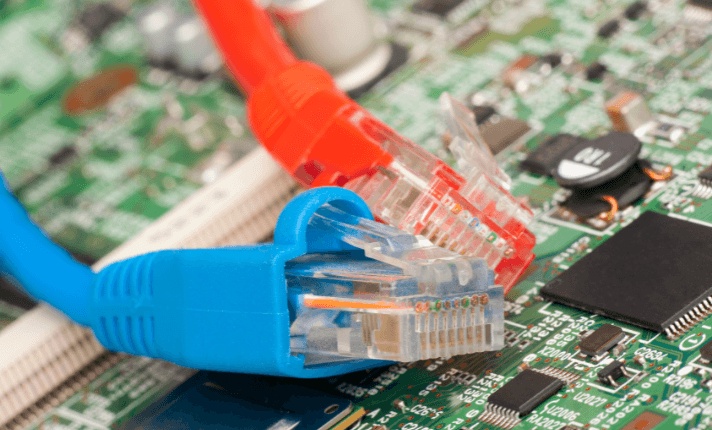The Cat6 ethernet cable is available in different variants. Distinguished by conductor type, jacket, and shielding. The cable is also one of the most widely used because of the wide variety of its types. To buy the Cat6 cable for the first time, you need to be familiar with its specifications and what its variants are like. One specification that is most important in the cable is its conductor. Because it is the primary factor that affects the cable’s performance.
The conductors of the Cat6 cable are bare copper and copper-clad aluminum. Both types of conductors are also available in solid and stranded types. Which one do you need and which one is better? Read on to find out.
Cat6 Cable
Cat6 ethernet cable is standardized by IEEE and ANSI/EIA/TIA. It has a 1 GBit/s data transfer rate of over 100 meters and 10 GBit/s over 50 meters. With such high-speed data transfer rates, the cable also has a 550 MHz bandwidth capacity, making it ideal for business and residential applications.
The conductors of the cable are 8 in total which is twisted into 4 pairs. The pairs are then separated by a wire separator which helps keep the electromagnetic interference and crosstalk at a minimum.
Cat6 CCA
Cat6 cables with the CCA conductors are relatively more affordable as compared to the bare copper Cat6 cables. These conductors have a bare copper plating on an aluminum base which improves the conductivity and ductility of the cable.
CCA Cat6 cables can be used for high-speed ethernet applications except for the PoE. PoE applications utilize more electrical power as compared to other uses. And this causes the CCA cables to overheat. In the worst-case scenario, this could cause a fire hazard.
Cat6 Plenum CCA: CMP-rated Cat6 CCA cables are designed for use in indoor plenum spaces. These spaces are the one's above-dropped ceilings or below raised floors. The jacket of the cable is its main highlight. It is made out of LSZH materials, which is the best option you can get.
Cat6 Riser CCA: CMR-rated Cat6 CCA cables are even more affordable than their CMP counterparts. The riser-rated jacket of this cable makes it ideal for use in indoor vertically rising spaces such as elevator shafts, between floors, and within walls.
Because of its affordability, the CCA Cat6 riser cable is used more readily in networks with a limited budget. In fact, it is also used outdoors because, although the conductors are not as good as bare copper, the jacket is pretty durable.
Cat6 Pure Copper
Pure copper or bare copper Cat6 is the cutting-edge solution for LAN networks. The conductor is either solid or stranded. More on that later.
This cable is made with high performance and reliability in mind. It allows an easy installation because of the conductor's ductility. It can be easily twisted and turned into any shape which reduces and eliminates kinks. The installation becomes even more convenient if the cable is shipped in an easy-pull box.
Bare copper Cat6 cable supports all high-speed applications including fast ethernet, gigabit ethernet, 10-gigabit Ethernet, PoE, PoE+/++, etc.
Cat6 Plenum Pure Copper: CMP-rated Cat6 plenum bare copper cable is designed to be installed in indoor plenum spaces. But because this jacket is highly resistant to extreme temperatures and durable in uncertain environments, it is also installed outdoors.
You can even directly bury it underground if you do not want to use a direct burial cable for any reason. Moreover, the pure copper conductor ensures a reliable and solid signal relay across all king's environments. And if you are using it for long-distance transmissions, this is the ideal choice.
Cat6 Riser Pure Copper: The CMR-rated Cat6 pure copper cable is the most used indoors. It is conclusively better than the CCA Cat6 riser. Because of this cable is integrated with 23 AWG bare copper conductors.
The conductors are either made from solid or stranded copper. In any case, it can deliver high performance in a variety of applications. Except, do not use it in indoor plenum ducts. Although it is fire-resistant, it can emit toxic smoke should it catch fire.
And that is the reason most building inspectors would never approve if you run it in indoor open (plenum) spaces.
Solid vs Stranded Cat6
Cat6 pure copper cable comes with two different types of conductors. Solid and stranded. The Cat6 solid copper cable is ideal for use in outdoor and long-distance runs. Because it can keep the signal integrity intact better and is also easy to install outdoors.
For instance, the Cat6 plenum solid copper cable is best utilized in outdoor spaces. If you need to run a cable from a server room to an outdoor IP security camera, this is the one for you. You can also use the Cat6 riser solid copper cable which is even more affordable and easier to install.
Cat6 Stranded Copper cable on the other hand is ideal for use in indoor spaces. It is more flexible and not as resilient towards interference as its solid counterpart. The core of this cable is made from multiple strands of bare copper and it is more susceptible to external noise.
But never underestimate how strong a signal it can relay. It is far better than the CCA Cat6 riser despite being stranded. Pun not intended.
Which One is Better?
Cat6 plenum and riser solid copper cables are the finest of all the Cat6 pure copper cables. Moreover, if you get these cables with internal shielding, their performance will improve even further.
But if you were to choose between the Cat6 plenum solid copper and Cat6 riser solid copper cables, the former would outpace the latter in performance, safety, reliability, and overall functionality. With the only exception of cost.


No comments yet